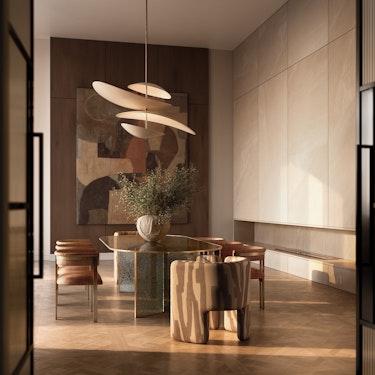In architecture and development, “branding” is often misunderstood — reduced to decorative visuals or high-gloss brochures. But real branding isn’t an aesthetic layer; it’s an operational mindset. It defines how your project is perceived, who it speaks to, and what cultural or emotional terrain it occupies.
Where traditional marketing pushes information, a brand pulls belief. It provides a framework to guide every decision — from spatial design to communication strategy. It turns a building into a symbol. In a global market where attention spans are short and competition is fierce, branding becomes strategic capital.
What Is a Content Ecosystem — and Why Does It Matter?
A content ecosystem is not a campaign. It’s a long-term architecture of storytelling touchpoints — visuals, words, platforms, and experiences — all designed to express and evolve the identity of your project.
This includes:
- High-quality renderings that depict emotion, not just structure
- Cinematic films that narrate vision, not just amenities
- Websites designed as immersive spaces, not sales pages
- Social media strategies that engage, not broadcast
- On-brand editorials and manifestos that define a cultural voice
- Influencer and media partnerships that amplify relevance and reach
It is multi-dimensional, cross-channel, and consistent. When designed well, it doesn’t just support the project — it becomes part of the project’s value.
Too often, content is seen as a marketing afterthought — something activated once construction begins. But the most powerful brands begin crafting their narrative from day zero. Because when your story is clear, every other layer — from design to delivery — gains coherence and confidence.

Industries Already Treating Brand as Asset
Real estate has been slow to adapt. But other industries provide blueprints for what’s possible:
Luxury fashion: Chanel doesn’t sell clothes — it sells a mythos of elegance, rebellion, and timelessness. Every campaign is a cinematic world that reinforces identity. Chanel’s narrative strategy turns product into cultural artifact.
Hospitality: Aman hotels maintain radical consistency across global destinations. Whether in Japan or Morocco, the tone, visuals, and guest experience are unified — because brand is the product. Aman’s design philosophy is communicated visually and emotionally — and amplified through every detail.
Automotive: Tesla built an entire ecosystem before the first cars reached mass market. Its story — innovation, sustainability, vision — precedes the product and frames it as future-ready.
In each case, content is not decoration. It is a strategic asset that compounds over time. Real estate developers who adopt this mindset early will gain cultural capital while others chase square footage.

Where Content-First Strategies Win
NEOM, Saudi Arabia
NEOM isn't just positioning itself as a city — it's branding itself as a civilizational leap. Its online presence is vast: emotionally charged films, multilingual campaigns, clear thematic pillars, and a compelling manifesto. NEOM’s brand is driving belief at global scale — long before most physical infrastructure is complete. It’s a masterclass in narrative-first development.
The OWO Residences by Raffles, London
This redevelopment of the iconic Old War Office doesn’t just sell historic luxury — it builds a story of diplomacy, drama, and detail. Through films, editorial partnerships, and a bespoke visual identity, the project blends heritage with ultra-premium positioning. Buyers don’t just purchase a residence — they buy into a storied lifestyle.
Capella Sydney
Before the building reopened, Capella launched a narrative-rich content campaign rooted in heritage, culture, and luxury experience. They released sensory films, editorial stories, and lush digital environments that created emotional anticipation. The project felt alive before it even opened.
These developers didn’t wait for project completion to activate their brand. They built ecosystems of meaning — and it paid off in awareness, reputation, and premium pricing.

How to Build a Content Ecosystem from Day One
Articulate the project’s core idea
Before visuals, define the narrative. Is it about sustainability? Craft? Urban vibrancy? Escape? Put this into a one-page manifesto — a clear, emotionally resonant statement that everyone can build from.
Map your storytelling channels early
Content isn’t linear. Think holistically: what will your brand say on Day 1? At soft launch? At grand opening? Define content touchpoints and schedule them to align with key project milestones.
Invest in visual storytelling
Generic renderings and templated flythroughs no longer cut it. Create emotionally driven visuals — cinematic, art-directed, human-centered.
Create for platforms, not just assets
A short film needs cuts for Instagram, YouTube, paid ads, even exhibitions. Design every content piece with adaptability in mind.
Collaborate with storytellers, not vendors
Work with studios that understand brand, place, and narrative. Your content creators should be strategic partners — not executional resources.
Measure and refine
Use analytics to see how your story is landing. Are people engaging with the film? Is social media building followers pre-launch? Is content driving leads? Treat content as you would architecture: designed, intentional, and iterative.

A building is temporary. A brand is scalable.
In today's hyper-competitive real estate landscape, a strong content ecosystem doesn't just sell property — it builds meaning, identity, and longevity.
When you treat branding as a business asset and content as its delivery system, your project stops competing on features — and starts resonating on values. This is how place becomes story. Story becomes trust. And trust becomes long-term value.
